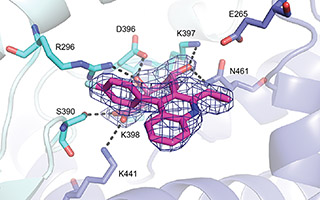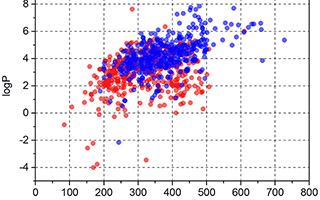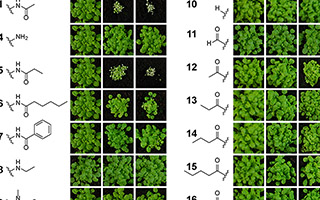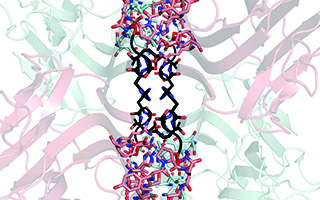Highlighted articles
The lab has led work published in journals that include Nature Chemical Biology, JBC, Angewandte Chemie, New Phytologist, Molecular Biology & Evolution, Chemistry & Biology, Plant Cell, Plant Journal, ACS Chemical Biology, Nature Communications, RSC Chemical Biology and eLife.
Below are six recent highlights with links to the them at PubMed and their DOI. For other ways to see the publications, you can see Google Scholar, ORCID or Publons. Scroll down for a full bibliography.
Research publications
Following is a complete list of publications in reverse chronological order. To date it includes 82 papers in journals including Nature, Science, Current Biology, PNAS, Genes & Development, and Chemical Science. Corresponded articles include ones to journals such as Nature Chemical Biology, JBC, Angewandte Chemie, Molecular Plant, New Phytologist, Molecular Biology & Evolution, Chemistry & Biology, Plant Cell, Plant Journal, ACS Chemical Biology and eLife.
Deane, Haywood, Wallace, Bernath-Levin, Waters, Mylne*, Stubbs* (2025) Sweet dicamba: a carbohydrate pro-herbicide strategy. RSC Chemical Biology . online. PubMed; DOI.
Haywood*, Breese, McDougal, Verdonk, Partridge, Lo, Zhang, Yang, Bruning, Saliba, Bond, Stubbs*, Mylne* (2025) Structural insights into a plant-conserved DHFR-TS reveal a selective herbicide target. Molecular Plant 18: 1294-1309 . PubMed; DOI.
Haywood, Breese, Muria-Gonzalez, Bernath-Levin, Waters, Stubbs*, Mylne* (2025) A non-volatile pro-dicamba herbicide inspired by meclofenoxate. Chem. Eur. J. e202404282. PubMed; DOI.
Hajiaghaalipour, Song, Vadlamani, Zhang, Mylne, Clark, Rosengren (2023) Molecular grafting can generate bioactivities within the cyclic peptide PDP-23. chemRxiv N/A: 2023-s1g30. DOI.
Haywood, Breese, Zhang, Waters, Bond, Stubbs, Mylne* (2022) A fungal tolerance trait and selective inhibitors proffer HMG-CoA reductase as a herbicide mode-of-action. Nature Communications 13: 5563. PubMed, DOI.
Vadlamani†, Sukhoverkov†, Haywood, Breese, Fisher, Stubbs, Bond, Mylne* (2022) Crystal structure of Arabidopsis thaliana HPPK/DHPS, a bifunctional enzyme and target of the herbicide asulam. Plant Communications 3: 100322. († joint authors) PubMed; DOI.
Pires, Stubbs, Mylne, Ascher (2022) cropCSM: designing safe and potent herbicides with graph-based signatures. Briefings in Bioinformatics bbac042: 24 February 2022. PubMed, DOI.
Sukhoverkov, Breese, Debowski, Murcha, Stubbs*, Mylne* (2022) Inhibition of chloroplast translation as a new target for herbicides. RSC Chemical Biology 3: 37-43. DOI; PubMed.
Payne, Fisher, Mylne, Rosengren (2021) Structural characterization of the PawL-derived Peptide family, an ancient subfamily of orbitides. J. Nat. Prod. 84: 2914-2922. PubMed, DOI.
Wallace, Debowski, Sukhoverkov, Mylne*, Stubbs* (2021) Herbicidal activity of fluoroquinolone derivatives. Plant Direct 5: e348. PubMed, DOI.
Payne, Vadlamani, Hajiaghaalipour, Muhammad, Fisher, Andersson, Göransson, Clark, Bond, Mylne, Rosengren (2021) Solution NMR and racemic crystallography provide insights into a novel structural class of cyclic plant peptides. RSC Chemical Biology 2: 1682-1691. PubMed, DOI.
Sukhoverkov & Mylne* (2021) Systematic, small-scale screening with Arabidopsis reveals herbicides synergies that extend to lettuce. Pest Management Science 77: 4930-4941. PubMed, DOI.
Nonis, Haywood, Schmidberger, Mackie, Soares da Costa, Bond, Mylne* (2021) Structural and biochemical analyses of concanavalin A circular permutation by jack bean asparaginyl endopeptidase. Plant Cell 33: 2794-2811. PubMed, DOI.
Payne, Franke, Fisher, Hajiaghaalipour, McAleese, Song, Eliasson, Zhang, Jayasena, Vadlamani, Clark, Minchin, Mylne, Rosengren (2021) A chameleonic macrocyclic peptide with drug delivery applications. Chem. Sci. 12: 6670-6683. PubMed, DOI.
Haywood, Vadlamani, Stubbs, Mylne* (2021) Antibiotic resistance lessons for the herbicide resistance crisis. Pest Management Science 77: 3807-3814. PubMed, DOI.
Nonis, Haywood, Mylne* (2021) Plant asparaginyl endopeptidases and their structural determinants of function. Biochemical Society Transactions 49: 965-976. PubMed, DOI.
Sukhoverkov, Corral, Leroux, Haywood, Johnen, Newton, Stubbs*, Mylne* (2021) Improved herbicide discovery using physico-chemical rules refined by antimalarial library screening. RSC Advances 11: 8459-8467. PubMed; DOI.
Mylne & Stubbs (2020) Antimalarial drugs as inspiration for herbicides. Outlooks on Pest Management 31: 216-220. DOI.
Payne, Vadlamani, Fisher, Zhang, Clark, Mylne, Rosengren (2020) Defining the familial fold of the vicilin-buried peptide family. J. Nat. Prod. 83: 3030-3040. PubMed, DOI.
Fisher, Payne, Chetty, Crayn, Berkowitz, Whelan, Rosengren, Mylne (2020) The genetic origin of evolidine, the first cyclopeptide discovered in plants, and related orbitides. J. Biol. Chem. 295: 14510-14521. PubMed, DOI.
Fisher, Zhang, Berkowitz, Whelan, Mylne (2020) Cyclic peptides in seed of Annona muricata are ribosomally synthesized. J. Nat. Prod. 83: 1167-1173. PubMed, DOI.
Behsaz, Mohimani, Gurevich, Prjibelski, Fisher, Smarr, Dorrestein, Mylne, Pevzner (2020) De novo peptide sequencing reveals many cyclopeptides in the human gut and other environments. Cell Systems 10: 99-108. PubMed, DOI
Fisher, Mylne (2019) Sequencing orbitides by acid-mediated ring cleavage followed by tandem mass spectrometry. J. Proteome Research 18: 4065-4071. PubMed, DOI.
Fisher, Payne, Rosengren, Mylne (2019) An orbitide from Ratibida columnifera seed containing 16 amino acid residues. J. Nat. Prod. 82: 2152-2158. PubMed, DOI.
Pullella, Wdowiak, Sykes , Lucatoni, Sukhoverkov, Zulfiqar , Sobolev, West, Mylne, Avery, Piggott (2019) Total synthesis of the antimalarial ascidian natural product albopunctatone. Org. Lett. 21:5519-5523. PubMed, DOI.
Pouvreau, Fenske, Ivanova, Murcha, Mylne (2019) An interstitial peptide is readily processed from within seed proteins. Plant Science 285: 175-183. PubMed, DOI.
Zhang, Payne, Pouvreau, Schaefer, Fisher, Taylor, Berkowitz, Whelan, Rosengren, Mylne (2019) An ancient peptide family buried within vicilin precursors. ACS Chemical Biology 14: 979-993. PubMed, DOI.
James, Haywood, Leroux, Ignasiak, Elliott, Schmidberger, Fisher, Nonis, Fenske, Bond, Mylne (2019) The macrocyclizing protease butelase 1 remains auto-catalytic and reveals the structural basis for ligase activity. Plant Journal 98: 988-999. PubMed, DOI.
Corral, Haywood, Stehl, Stubbs, Murcha, Mylne (2018) Targeting plant DIHYDROFOLATE REDUCTASE with antifolates and mechanisms for genetic resistance. Plant Journal 95: 727-742. PubMed, DOI.
Fisher, Zhang, Taylor, Howard, Berkowitz, Debowski, Behsaz, Whelan, Pevzner, Mylne (2018) A family of small, cyclic peptides buried in preproalbumin since the Eocene epoch Plant Direct 2: e00042. PubMed, DOI.
Haywood, Schmidberger, James, Nonis, Sukhoverkov, Elias, Bond, Mylne (2018) Structural basis of ribosomal peptide macrocyclization in plants. eLife 7: e32955. PubMed, DOI.
Corral, Leroux, Tresch, Newton, Stubbs*, Mylne* (2018) A herbicide structure-activity analysis of the antimalarial lead compound MMV007978 against Arabidopsis thaliana. Pest Manag. Sci. 77: 1558-1563. PubMed, DOI.
Franke, Mylne, Rosengren (2018) Buried treasure: biosynthesis, structures and applications of cyclic peptides hidden in seed storage albumins. Nat. Prod. Rep. 35: 137-146. PubMed, DOI.
Wallace, Waraich, Debowski, Corral, Maxwell, Mylne*, Stubbs* (2018) Developing ciprofloxacin analogues against plant DNA gyrase: A novel herbicide mode of action. Chem. Commun. 54: 1869-1872. PubMed, DOI.
James, Haywood, Mylne (2018) Macrocyclization by asparaginyl endopeptidases. New Phytologist 218: 923-928. PubMed, DOI.
Corral, Leroux, Tresch, Newton, Stubbs*, Mylne* (2017) Exploiting the evolutionary relationship between malarial parasites and plants to develop new herbicides. Angew. Chem. Int. Ed. Engl. 56: 9881-9885. PubMed, DOI.
Franke, James, Mobli, Colgrave, Mylne, Rosengren (2017) Two proteins for the price of one: structural studies of the dual-destiny Preproalbumin with Sunflower Trypsin Inhibitor-1. J. Biol. Chem. 292: 12398-12411. PubMed, DOI.
Corral, Leroux, Stubbs, Mylne (2017) Herbicidal properties of antimalarial drugs Scientific Reports 7: 45871. PubMed, DOI.
Jayasena, Fisher, Panero, Secco, Bernath-Levin, Berkowitz, Taylor, Schilling, Whelan, Mylne (2017) Stepwise evolution of a buried inhibitor peptide over 45 million years. Molecular Biology and Evolution 34: 1505-1516. PubMed, DOI.
James, Jayasena, Zhang, Berkowitz, Secco, Knott, Whelan, Bond, Mylne (2017) Evidence for ancient origins of Bowman-Birk inhibitors from Selaginella moellendorffii. Plant Cell 29: 461-473. PubMed, DOI.
Grage, Sani, Cheneval, Henriques, Schalck, Heinzmann, Mylne, Mykhailiuk, Afonin, Komarov, Separovic, Craik, Ulrich (2017) Orientation and location of the cyclotide kalata B1 in phospholipid bilayers revealed by solid-state NMR. Biophysical Journal 112: 630-642. PubMed, DOI.
Elliott, Franke, Armstrong, Craik, Mylne*, Rosengren* (2017) Natural structural diversity within a conserved cyclic peptide scaffold. Amino Acids 49: 103-116. PubMed, DOI.
Franke, Jayasena, Fisher, Swedberg, Taylor, Mylne, Rosengren (2016) Diverse cyclic seed peptides in the Mexican zinnia (Zinnia haageana). Biopolymers 106: 806-817. PubMed, DOI.
Franke, Colgrave, Mylne, Rosengren (2016) Mature forms of the major seed storage albumins in sunflower: a mass spectrometric approach. Journal of Proteomics 147: 177-186. PubMed, DOI.
Evans-Roberts, Mitchenall, Wall, Leroux, Mylne, Maxwell (2016) DNA gyrase is the target for the quinolone drug ciprofloxacin in Arabidopsis thaliana. J. Biol. Chem. 291: 3136-3144. PubMed, DOI.
Jayasena, Franke, Rosengren, Mylne (2016) A tripartite approach identifies the major sunflower seed albumins. Theoretical and Applied Genetics 129: 613-629. PubMed, DOI.
Bernath-Levin, Nelson, Elliott, Jayasena, Millar, Craik, Mylne (2015) Peptide macrocyclization by a bifunctional endoprotease. Chemistry & Biology 22: 571–582. PubMed, DOI.
Gandy, Corral, Mylne*, Stubbs* (2015) An interactive database to explore herbicide physicochemical properties. Organic & Biomolecular Chemistry 13: 5586-5590. (*co-corresponding) PubMed, DOI.
Mahatmanto, Mylne, Poth, Swedberg, Kaas, Schaefer, Craik (2015) The evolution of Momordica cyclic peptides. Molecular Biology and Evolution 32: 392-405. PubMed, DOI.
Jayasena, Secco, Berkowitz, Bernath-Levin, Whelan, Mylne (2014) Next generation sequencing and de novo transcriptomics to study gene evolution. Plant Methods 10: 34. PubMed, DOI.
Elliott, Delay, Liu, Phua, Rosengren, Benfield, Panero, Colgrave, Jayasena, Dunse, Anderson, Schilling, Ortiz-Barrientos, Craik, Mylne (2014) Evolutionary origins of a bioactive peptide buried within preproalbumin. Plant Cell 26: 981-995. PubMed, DOI.
Mylne, Hara-Nishimura, Rosengren (2014) Seed storage albumins: biosynthesis, trafficking and structures (Goldacre Review). Functional Plant Biology 41: 671-677. DOI, PubMed.
Mahatmanto, Poth, Mylne, Craik (2014) A comparative study of extraction methods reveals preferred solvents for cystine-knot peptide isolation from Momordica cochinchinensis seeds. Fitoterapia 95: 22-33. PubMed, DOI.
Rosa*, De Lucia*, Mylne*, Zhu*, Ohmido, Pendle, Kato, Shaw, Dean (2013) Physical clustering of FLC alleles during Polycomb-mediated epigenetic silencing in vernalization. Genes & Development 27: 1845-1850. (*equal) PubMed, DOI.
King, Chanson, McCallum, Ohme-Takagi, Byriel, Hill, Martin, Mylne (2013) The Arabidopsis B3 domain protein VERNALIZATION1 is involved in processes essential for development with structural and mutational studies revealing its DNA binding surface. J. Biol. Chem. 288: 3198–3207. PubMed, DOI.
Mylne, Chan, Chanson, Daly, Schaefer, Bailey, Nguyencong, Cascales, Craik (2012) Cyclic peptides arising by evolutionary parallelism via asparaginyl-endopeptidase mediated biosynthesis. Plant Cell 24: 2765-2778. PubMed, DOI.
Poth, Mylne, Grassl, Lyons, Millar, Colgrave, Craik (2012) Cyclotides associate with leaf vasculature and are the products of a novel precursor in Petunia (Solanaceae). J. Biol. Chem. 287: 27033-27046. PubMed, DOI.
Craik, Henriques, Mylne, Wang (2012) Cyclotide isolation, characterization and bioassay. in Natural product biosynthesis by microorganisms and plants (3rd edition) Methods in Enzymology 516: 37-62. PubMed, DOI.
Craik, Swedberg, Mylne, Cemazar (2012) Cyclotides as a basis for drug design. Expert Opinion on Drug Discovery 7:179-194. PubMed, DOI
Mylne, Mas, Hill (2012) NMR assignment and secondary structure of the C-terminal DNA binding domain of Arabidopsis thaliana VERNALIZATION1. Biomolecular NMR Assignments 6: 5-8. PubMed, DOI.
Mohimani, Liu, Mylne, Poth, Colgrave, Tran, Selsted, Dorrestein, Pevzner (2011) Cycloquest: Identification of cyclopeptides via database search of their mass spectra against genome databases. Journal of Proteome Research 10: 4505-4512. PubMed, DOI.
Mylne & Wigge (2011) Florigen takes two to tango. Nature Chemical Biology 7:665-666. PubMed, DOI.
Elliott, Craik, Mylne (2011) Sunflower trypsin inhibitor-1: chemical v. biological synthesis. Proceedings of the 22nd American Peptide Symposium, ed. Michal Lebl, Prompt Scientific Publishing, San Diego, CA, pp86-87. PDF.
Mylne, Colgrave, Daly, Chanson, McCallum, Jones, Elliott, Craik (2011) Albumins and their processing machinery are hijacked for cyclic peptides in sunflower. Nature Chemical Biology 7: 257-259. PubMed, DOI.
Box, Coustham, Dean, Mylne (2011) Protocol: A simple phenol-based method for 96-well extraction of high quality RNA from Arabidopsis. Plant Methods 7: 7. PubMed, DOI.
Mylne, Wang, van der Weerden, Craik (2010). Cyclotides are a component of the innate defence of Oldenlandia affinis. Biopolymers (Pept. Sci.) 94: 635-646. PubMed, DOI.
Qin, McCallum, Kaas, Saska, Craik, Mylne (2010). Identification of candidates for cyclotide biosynthesis and cyclization by expressed sequence tag analysis of Oldenlandia affinis. BMC Genomics 11: 111. PubMed, DOI.
Craik, Mylne, Daly (2010). Cyclotides: macrocyclic peptides with applications in drug design and agriculture. Cell. Mol. Life Sci. 67: 9-16. PubMed, DOI.
Trabi, Mylne, Sando, Craik (2009). Circular proteins from Melicytus (Violaceae) refine the conserved protein and gene architecture of cyclotides. Organic & Biomolecular Chemistry. 7: 2378 – 2388. PubMed, DOI.
King, Hill, Martin, Mylne (2009). Expression, purification and preliminary X-ray diffraction studies of VERNALIZATION1208-341 from Arabidopsis thaliana. Acta Crystallogr. F 65: 291-294. PubMed, DOI.
Pien, Fleury, Mylne, Crevillen, Inzé, Avramova, Dean, Grossniklaus (2008). ARABIDOPSIS TRITHORAX1 dynamically regulates FLOWERING LOCUS C activation via histone 3 lysine 4 trimethylation. Plant Cell 20: 580-588. PubMed, DOI.
Mylne & Craik (2008). 15N cyclotides by whole plant labeling. Biopolymers (Pept. Sci.) 90: 575-580. PubMed, DOI.
Herrmann, Burman, Mylne, Karlsson, Gullbo, Craik, Clark, Göransson (2008). The alpine violet, Viola biflora, is a rich source of novel cyclotides with potent cytotoxicity. Phytochemistry 69: 939-952. PubMed, DOI.
Greb*, Mylne*, Crevillen, Geraldo, An, Gendall, Dean (2007). The PHD finger protein VRN5 functions in the epigenetic silencing of Arabidopsis FLC. Current Biology 17: 73-78. (*equal). PubMed, DOI.
Mulvenna, Mylne, Bharathi, Burton, Shirley, Fincher, Anderson, Craik (2006). Discovery of cyclotide-like protein sequences in graminaceous crop plants: ancestral precursors of circular proteins? Plant Cell 18: 2134-2144. PubMed, DOI.
Mylne, Barrett, Tessadori, Mesnage, Johnson, Bernatavichute, Jacobsen, Fransz, Dean (2006). LHP1, the Arabidopsis homologue of HETEROCHROMATIN PROTEIN1 is required for epigenetic silencing of FLC. Proc. Natl Acad. Sci. U.S.A. 103: 5012-5017. PubMed, DOI.
Petsch, Mylne, Botella (2005). Cosuppression of eukaryotic release factor 1-1 in Arabidopsis affects cell elongation and radial cell division. Plant Physiology 139: 115-126. PubMed, DOI.
Mylne, Greb, Lister and Dean (2004). Epigenetic Regulation in the Control of Flowering. in Epigenetics, eds. Stillman & Stewart (CSHL Press, Cold Spring Harbor, New York), Vol. LXIX, pp. 457–464. PubMed, PDF.
Bastow, Mylne, Lister, Lippman, Martienssen, Dean (2004). Vernalization requires epigenetic silencing of FLC by histone methylation. Nature 427: 164-167. PubMed, DOI.
Boss, Bastow, Mylne, Dean (2004). Multiple pathways in the decision to flower: enabling, promoting, and resetting. Plant Cell 16: S18-31. PubMed, DOI.
Levy, Mesnage, Mylne, Gendall, Dean (2002). Multiple roles of Arabidopsis VRN1 in vernalization and flowering time control. Science 297: 243-246. PubMed, DOI.
Mylne, Botella (1998). Binary vectors for sense and antisense expression of Arabidopsis ESTs. Plant Molecular Biology Reporter 16: 257-262. DOI.
Mylne, Mason, Botella (1998). Rapid isolation of high-quality RNA from symbiotic dinoflagellates. Phycologia 37: 307-309. DOI.
Science Communication
The following published articles are not peer reviewed, but instead are written for a more general audience.
Mylne & Haywood (2022) Behind the paper: A fungal tolerance trait and selective inhibitors proffer HMG-CoA reductase as a herbicide mode-of-action. Nature Portfolio Chemistry Community Published Sep 23, 2022. Link
Mylne (2017) Malaria drugs offer new herbicide targets. Australasian Science 38(5): 28-29. PDF
Mylne (2016) Protein scissors that also learned to glue. Australasian Science 37(2): 34-35. PDF
Mylne (2014) A protein is born. Australasian Science 35(7): 28-30. Link
Mylne (2014) Genes that cuddle in the cold. Australasian Science 38(5): 28-29. Link
Mylne (2011) The Perfect Pill. Australasian Science 32(7): 30-32. Link
Mylne (2010) Sunflower’s Hidden Medical Molecule. The Sunflower – A Publication of the National Sunflower Association October/November issue: pp28-29. Link

Nexgen-UWA Press Release
New collaboration to help fight growing herbicide resistance (5 December 2019).

ABC Landline
Roundup Row: The row over the world's most popular weed-killer (6 July 2019).
ABC website, see 06:00 and 12:49

IFLScience.com
Antimalarial Drugs Could Provide Future Herbicides (11 July 2017).

42evolution.org Interview
FortyTwo Evolution Interview, Cambridge UK (26 September 2014).
Covers
The following images accompany manuscripts led by the lab and have appeared on the covers of journals.

Kirill Sukhoverkov et al. (2022) RSC Chemical Biology
- Cover Art by: Tiana Hunt, The Creative Hunt (zoom full image)
- Accompanying paper: Inhibition of chloroplast translation as a new target for herbicides
- Authors: Kirill Sukhoverkov, Karen Breese, Aleksandra Debowski, Monika Murcha, Keith Stubbs and Joshua Mylne
- Abstract: The rise in herbicide resistance over recent decades threatens global agriculture and food security and so discovery of new modes of action is increasingly important. Here we reveal linezolid, an oxazolidinone antibiotic that inhibits microbial translation, is also herbicidal. To validate the herbicidal mode of action of linezolid we confirmed its micromolar inhibition is specific to chloroplast translation and did not affect photosyn ... [more at PubMed]

Mark Fisher et al. (2020) Journal of Biological Chemistry
- Cover Art by: Tiana Hunt, The Creative Hunt (zoom full image)
- Accompanying paper: The genetic origin of evolidine, the first cyclopeptide discovered in plants, and related orbitides
- Authors: Mark Fisher, Colton Payne, Thaveshini Chetty, Darren Crayn, Oliver Berkowitz, Jim Whelan, Johan Rosengren, Joshua Mylne
- Abstract: Cyclic peptides are reported to have antibacterial, antifungal and other bioactivities. Orbitides are a class of cyclic peptide that are small, head-to-tail cyclized, composed of proteinogenic amino acids, and lack disulfide bonds; they are also known in several genera of the plant family Rutaceae. Melicope xanthoxyloides is the Australian rain forest tree of the Rutaceae family in which evolidine - the first plant cyclic peptide ... [more at PubMed]

Jingjing Zhang et al. (2019) ACS Chemical Biology
- Cover Art by: Scot Nicholls, Domokun Design (zoom full image)
- Accompanying paper: An ancient peptide family buried within vicilin precursors
- Authors: Jingjing Zhang, Benjamin Pouvreau, Mark Fisher, Nicolas Taylor, Colton Payne, Oliver Berkowitz, Jim Whelan, Johan Rosengren, Joshua Mylne
- Abstract: New proteins can evolve by duplication and divergence or de novo, from previously noncoding DNA. A recently observed mechanism is for peptides to evolve within a “host” protein and emerge by proteolytic processing. The first examples of such interstitial peptides were ones hosted by precursors for seed storage albumin. Interstitial peptides have also been observed in precursors for seed vicilins, but current evidence for vicilin-buried peptides (VBPs) is limited to seeds of the broadleaf plants pumpkin and ... [more at PubMed]

Bastian Franke et al. (2018) Natural Product Reports
- Cover Art by: Johan Rosengren, UQ (zoom full image)
- Accompanying paper: Buried treasure: biosynthesis, structures and applications of cyclic peptides hidden in seed storage albumins
- Authors: Bastian Franke, Joshua Mylne, Johan Rosengren
- Abstract: The small cyclic peptide SunFlower Trypsin Inhibitor-1 (SFTI-1) from sunflower seeds is the prototypic member of a novel family of natural products. The biosynthesis of these peptides is intriguing as their gene-encoded peptide backbone emerges from a precursor protein that also contains a seed storage albumin. The peptide sequence is cleaved out from the precursor and cyclised by the albumin-maturing enzymatic machinery. Three-dimensional solution NMR structures of a number of these peptides, and of the ... [more at PubMed]

Bastian Franke et al. (2017) J. Biol. Chem.
- Cover Art by: Johan Rosengren, UQ (zoom full image)
- Accompanying paper: Two proteins for the price of one: structural studies of the dual-destiny Preproalbumin with Sunflower Trypsin Inhibitor-1
- Authors: Bastian Franke, Amy James, Mehdi Mobli, Michelle Colgrave, Joshua Mylne, Johan Rosengren
- Abstract: Seed storage proteins are both an important source of nutrition for humans and essential for seedling establishment. Interestingly, unusual napin-type 2S seed storage albumin precursors in sunflowers contain a sequence that is released as a macrocyclic peptide during post-translational processing. The mechanism by which such peptides emerge from linear precursor proteins has received increased attention; however, the structural characterization of intact precursor proteins has been limited. Here, we report ... [more at PubMed]

Amy James et al. (2017) Plant Cell
- Cover Art by: Scot Nicholls, Domokun Design (zoom full image)
- Accompanying paper: Evidence for ancient origins of Bowman-Birk inhibitors from Selaginella moellendorffii
- Authors: Amy James, Achala Jayasena, Jingjing Zhang, Oliver Berkowitz, David Secco, Gavin Knott, Jim Whelan, Chales Bond, Joshua Mylne
- Abstract: Bowman-Birk Inhibitors (BBIs) are a well-known family of plant protease inhibitors first described 70 years ago. BBIs are known only in the legume (Fabaceae) and cereal (Poaceae) families, but peptides that mimic their trypsin-inhibitory loops exist in sunflowers (Helianthus annuus) and frogs. The disparate biosynthetic origins and distant phylogenetic distribution implies these loops evolved independently, but their structural similarity suggests a common ancestor. Targeted bioinformatic searches for the ... [more at PubMed]

Michael Gandy et al. (2015) Org. Biomol. Chem.
- Cover Art by: Maxime Corral, UWA (zoom full image)
- Accompanying paper: An interactive database to explore herbicide physicochemical properties
- Authors: Michael Gandy, Maxime Corral, Keith Stubbs, Joshua Mylne
- Abstract: Herbicides are an essential tool not only in weed management, but also in conservation tillage approaches to cropping. The first commercial herbicides were released in the 1940s and hundreds more since then, although genetic resistance to them is an issue. Here, we review the experimental and estimated physico-chemical properties of 334 successful herbicidal compounds and make available a dynamic electronic database containing detailed analyses of the main chemical properties for herbicides and which adopts ... [more at PubMed]

Kalia Bernath-Levin et al. (2015) Chemistry & Biology
- Cover Art by: Scot Nicholls, Domokun Design (zoom full image)
- Accompanying paper: Peptide macrocyclization by a bifunctional endoprotease
- Authors: Kalia Bernath-Levin, Clark Nelson, Alysha Elliott, Achala Jayasena, Harvey Millar, David Craik, Joshua Mylne
- Abstract: Proteases usually cleave peptides, but under some conditions, they can ligate them. Seeds of the common sunflower contain the 14-residue, backbone-macrocyclic peptide sunflower trypsin inhibitor 1 (SFTI-1) whose maturation from its precursor has a genetic requirement for asparaginyl endopeptidase (AEP). To provide more direct evidence, we developed an in situ assay and used 18O-water to demonstrate that SFTI-1 is excised and simultaneously macrocyclized from its linear precursor. The reaction is inefficient ... [more at PubMed]

Alysha Elliott et al. (2014) Plant Cell
- Cover Art by: Scot Nicholls, Domokun Design (zoom full image)
- Accompanying paper: Evolutionary origins of a bioactive peptide buried within preproalbumin
- Authors: Alysha Elliott, Cristina Delay, Huanle Liu, Zaiyang Phua, Johan Rosengren, Aurélie Benfield, Jose L. Panero, Michelle Colgrave, Achala Jayasena, Kerry Dunse, Marilyn Anderson, Edward E. Schilling, Daniel Ortiz-Barrientos, David Craik, Joshua Mylne
- Abstract: The small cyclic peptide SunFlower Trypsin Inhibitor-1 (SFTI-1) from sunflower seeds is the prototypic member of a novel family of natural products. The biosynthesis of these peptides is intriguing as their gene-encoded peptide backbone emerges from a precursor protein that ... [more at PubMed]

Joshua Mylne (2014) Australasian Science
- Cover Art by: Australasian Science (zoom full image)
- Accompanying article: Genes that cuddle in the cold
- Authors: Joshua Mylne
- Abstract: An ingenious experiment has allowed scientists to observe how plant genes move around the nucleus to locations that either stop or stimulate flowering depending on temperature.
- Related paper: Rosa et al. (2013) "Physical clustering of FLC alleles during Polycomb-mediated epigenetic silencing in vernalization" Genes Dev. 27(17):1845-50. [View at PubMed]

Joshua Mylne et al. (2014) Functional Plant Biology
- Cover Art by: Joshua Mylne, UWA (zoom full image)
- Accompanying paper: Seed storage albumins: biosynthesis, trafficking and structures (Goldacre Review)
- Authors: Joshua Mylne, Ikuko Hara-Nishimura, Johan Rosengren
- Abstract: Seed storage albumins are water-soluble and highly abundant proteins that are broken-down during seed germination to provide nitrogen and sulfur for the developing seedling. During seed maturation these proteins are subject to post-translational modifications and trafficking before they are deposited in great quantity and with great stability in dedicated vacuoles. This review will cover the subcellular movement, biochemical processing and mature structures of seed storage napins.








